#cadence wagner
Explore tagged Tumblr posts
Text

Some couples have one child, some have two, and some have three...but rarely do they have twelve! For Colin and Sophia Wagner, this shocking statistic is more than a concept...it's real life. On tonight's season premiere of Freaky Families, we'll experience a week in the life of the Wagners, learning everything from how many eggs they eat in a morning to just how everyone stays sane!

The answer to that last question, by the way, is faith. The Wagners are a devoutly Christian family, attending church twice-weekly (at minimum!) and praying morning, noon, and night. Colin and Sophia cite their belief in God and the Bible as the impetus to have such a large family.

Sophia: We aim to dress and behave righteously at all times in order to live out God's perfect plan for our lives.
But what does "righteously" mean, exactly? We recruited a couple of the Wagner kids to set us straight.

Charlotte, 13: Living righteously means we dress modestly and protect ourself from sinful influences at all times in order to set the best example for everyone around us.
Eldest daughter Charlotte is "essential" to the smooth running of the family machine, says mom Sophia, and I think I know why! She certainly knows the Wagner creed front to back and back to front. Eldest son Colin Ezekiel Jr., known to everyone as "Zeke," and daughter Cadence also weigh in:
Colin Jr. "Zeke," 12: The boys do boy things, like playing outside, and the girls do girl things. That way nobody gets confused.
Cadence, 9: I guess it means...not listening to secular music, and playing praise hymns instead.
Well, there you have it, folks. The Wagners will be back after the break!
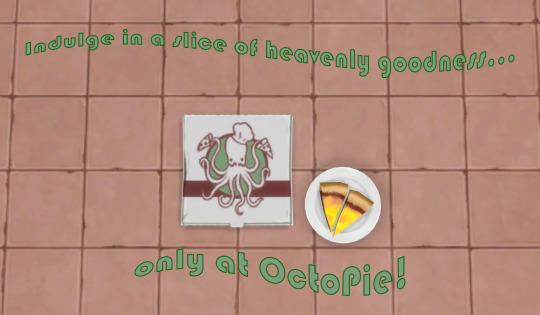

#i hope you all liked my facsimile of a reality show special :) more to come soon#colin wagner#sophia wagner#colin and sophia#charlotte wagner#colin wagner jr.#cadence wagner#slc#publicity#wagners#wagner family#gen1#**#fundie sims#quiverfull sims#modest sims#homeschool sims#reality tv#ts4#sims 4#ts4 legacy#sims 4 story#sims 4 screenshots
20 notes
·
View notes
Text
Terrifying Transformations: An Anthology of Victorian Werewolf Fiction – Assorted Lycanthrope Flavors
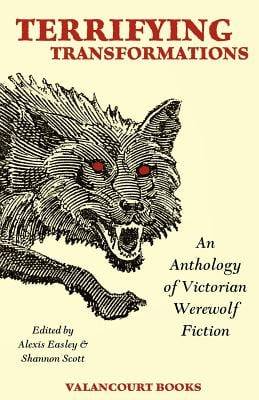
After meandering through it for months—I cracked this book open in March—I finally picked my way through Terrifying Transformations: An Anthology of Victorian Werewolf Fiction, edited by Alexis Easley and Shannon Scott. The categories I parted them into:
SPOILERS BELOW
Stories I Would Return to Out of Enjoyment
“The White Wolf of the Hartz Mountains” by Frederick Marryat– Actually a segment taken from a larger novel, The Phantom Ship, but an excellent classic Beware of the New Woman who is Scary and Evil horror. Has a good helping of Fair Folk elements too.
“Lycanthropy in London; or, The Wehr-Wolf of Wilton-Crescent” by Dudley Costello – A rare somewhat comedic take, displaying what looks to be Mr. Costello gleefully calling bullshit on the entirety of physiognomy and the type of people who latch onto pseudoscience and faux mystic intuitions to declare a stranger has Bad Vibes ™ and is probably a vicious werewolf in disguise! Has a happy ending though.
“The Gray Wolf” by George Macdonald – Leans almost in a folktale direction. Hot wolf girl seeks wandering young man. Some blood is shed. It’s fine.
“The Were-wolf of the Grendelwold” by F. Scarlett Potter – A rare case of the werewolf having something like the usual vampiric seductive-coercive power over a target, nearly to the point of a devilish archetype. A lot of corpses by the end.
“Dracula’s Guest” by Bram Stoker – Proto-Jonathan Harker being a proud and haughty Englishman disregarding the locals’ fears only to nearly get chomped by a vampire horde! Dracula in a werewolfish role! Sharing wine with the manly soldier who shared his horse with you! Fun stuff.
“Where There is Nothing There is God” by William Butler Yeats – Period typical problematic bits with the poor kid involved, but a surprising twist on dubbing the werewolf-adjacent character a kind and magical holy figure in disguise.
“A Ballad of the Were-Wolf” by Rosamund Marriott Watson – A decent Victorian stab at ye olde English poetry regarding a bloody werewolf tale.
Stories I Would Return to Only to Reference in a Period Piece to Highlight What a Terrible View People of the Time Had Regarding People They Want to Demonize By Calling Them Werewolves (or Were Otherwise Just Not That Engaging)
“Wagner, the Wehr-Wolf” by G.W. M. Reynolds – Skipped entirely! The intro pointed out the guy was a plagiarist. Immediate pass.
“The White Wolf of Kostopchin” by Gilbert Campbell – Dragged too much for me to get interested. More imperiled children, more Scary Evil Powerful Lady wolf.
“The Mark of the Beast” by Rudyard Kipling – Old-fashioned Scary Magic Retaliation Curse from Scary Indian (actual India, not Native American) after an Englishman was a jackass in a temple. Too much colonialism glaze on this one for me. Pretty straightforward man-to-beast gimmick, nothing fancy.
“The Were-Wolf” by Clemence Housman – Starts out as a promising Nordic-flavored shapeshifter tale, but ultimately peters out into an incredibly on-the-nose ‘Christlike sacrifice for the Greater Good!’ end. Good effort on characterization, but ultimately felt like a letdown.
“The Other Side: A Breton Legend” by Eric Stenbock – Once again, comes with the Christianity cure-all sledgehammer at the end. Has a refreshingly witchy buildup, at least. Fairy tale angles.
“Morraha” a Celtic tale recorded by Joseph Jacobs – Not great, not terrible. Would have been more enjoyable if the telling was worded less like a rambling Madlibs game of ‘and then this happened and then this and then this.’ It does have a cadence pretty close to old fairy tale recitations which are notoriously incredibly condensed and very hit or miss for me, so I could just be biased.
Stories About Regular People Being Mistaken for Werewolves via Trickery, Idiocy, or Belief in Lycanthropy/‘Wolf Madness’ as an Actual Mental Illness
“Hugues the Wer-Wolf” by Sutherland Menzies – Every other paragraph had me going, “Hmm. That’s a bit fucked up. (depressing)”
“A Story of a Weir Wolf” by Catherine Crowe – Simultaneously vindicating and deeply saddening.
“Lycanthropy in London; or, The Wehr-Wolf of Wilton-Crescent” by Dudley Costello – See above.
“A Pastoral Horror” by Arthur Conan Doyle – Crazy murderer in the Alps. Bit of a stretch to include this one, I think. No real wolfish traits on display, but it does nod to the old ‘if you wound a werewolf in lupine form, it will show the mark in human shape!’ trope a little. Not Doyle’s best, not his worst.
Not Stories, Just Victorian Attempts at ‘Educating’ on Lycanthropy
“Wolf-Children” from Chambers’ Edinburgh Journal
“Wolf Lore” from Once a Week
“The Book of Were-Wolves: Being an Account of a Terrible Superstition” (Excerpt) by Sabine Baring-Gould
Overall I was deeply surprised at seeing so little in this collection that had anything to do with werewolves within England as a setting. So much of it is just tucked away in other countries happening in 'uncivilized' (read: not England) territories. I suppose that keeps in parallel with the vampire fiction fascination, with all these blood-drinking undead having come from far off places or older less-than-modern corners of the world. But even Dracula got around to menacing London! And yet there’s not one measly wolfman wandering around the cities? Genuinely shocked.
#An American Werewolf in London led me to believe there was at least a small native werewolf population#apparently not#werewolf#literature#Terrifying Transformations: An Anthology of Victorian Werewolf Fiction#books
17 notes
·
View notes
Text
Two decades late, but inspired by the movie of all things. So here's a brief analysis of Wicked Act I and the importance of key signatures.
First an overview of post-Wagner key signature conventions.

It is quite common post-Wagner to have the entirety of an act or even the whole opera to work towards the resolution of one chord. Composers sometimes are very careful to never play the final chord in order to trigger that feeling of catharsis and arrival. Wagner was known to underpin every song with the dominant, while also orchestrating it so it feels unstable, thus making the audience on edge. So once the final chord is played, there is a feel of "finally". He weaponised music theory to make the audience feel just as much longing as the character themselves. Schwartz is well-versed in music history, so I have no doubt the following key signature choices are intentional. This is especially true since many well-known composers also utilised this technique, such as Sondheim, Webber, and Zimmer. Schwartz also collaborated with Zimmer multiple times, and we can see their influence upon each other in later works.

Now, let's break down the keys of the major musical numbers we'll be looking at.
1) The Wizard and I - Ab+

2) What is this Feeling & Popular - C+


3) Dancing through Life - F+

4) I'm not that Girl - A+

5) Defying Gravity - Db+

It's clear based on orchestration and important moments that Schwartz had chosen to represent characters and their "true selves" using a key that represents them. Elphaba is Db+ because of its darkness and seriousness. Galinda's is C because of its purity and cleanness. Fiyero's is F for whatever the fuck. It's like the hardest key to sing in but go off.

Now, the relationship between "The Wizard and I" and "Defying Gravity" is meant to demonstrate that the "I want" song is the dominant to the resolution of Elphaba's character arc in "Defying Gravity". This is why "The Wizard and I" cycles through a bunch of keys while never touching Db, each time climbing higher and higher, closer and closer to Db, but stopping short at C.





Galinda being in C+ demonstrates how close she is to Elphaba, but the two actually being very different. Db and C are not pleasant notes to hear next to each other. But, C is the leading tone to Db, so in a way, Galinda is a very necessary part of Elphaba. She is the stepping stone to Elphaba becoming who she really is.

The most interesting part for me is the keys between "Dancing Through Life" and "I'm not that Girl".

Fiyero's key is F+, this the audience and Elphaba knows because we heard his song before Elphaba's final transformation. Elphaba likes him but doesn't think she's the right match for him. This realisation is expressed through "I'm not that Girl", which is in A+. A+ is the mediant of F+, expressing a desire to harmonise with him and be a pair with him. It is one of the rare songs that doesn't skip through a million keys, demonstrating her very earnest desire to be that girl, but recognising she is not.

However, with "Defying Gravity", it becomes clear that Elphaba's key is Db major, which means Fiyero is the mediant to her key. He is meant to harmonise with her. Elphaba is so desperate to spin around someone else's orbit, that she doesn't realise she's literally the sun and Fiyero spins around her.

We see a glimmer of her realising this is true in "I'm not that Girl" as well. In "I'm not that Girl", Schwartz uses compound time to represent fantasy, and simple time represents reality. When she's talking about "what could have been" in her 6/8 fantasy land, the chords are in Db major. But only for two fucking bars. Schwartz goes Ab -> Db (cadences) but it's Db add9, meaning it doesn't quite sound right. However, it is an early hint that Elphaba recognises this as "a love she assumed she lost" when in reality, she knows that she is the tonic to her own song.

Also, at the end of "Popular", Galinda modulates from C+ to F+, demonstrating that being popular ultimately is about being like Fiyero. It's also reflected in the lyrics of both "Dancing through Life" and "Popular", where the underlying ethos is "form over content". So at that moment, we truly feel like Galinda and Fiyero belong together due to their shared ethos and now shared key.

But Elphaba changes everything... Because with the last song, we recognise that as the true cadence. The entirety of the first act is in Db major, making Ab the dominant (the earnest desire), F the mediant (a pretty harmony), and A an unfortunate passing tone. Elphaba was never meant to be someone's girl. Fiyero was meant to be her guy.

#Wicked#music analysis#stephen schwartz#my thoughts#other music nerds chime in#I have more to say on the use of compound vs duple time#and use of triplets#And voice painting#and harmony#and tritones#but imma hold back#until I can write a coherent analysis like this one
7 notes
·
View notes
Text
꧁༺ 𝓣𝓱𝓮 𝓛𝓸𝓿𝓮𝓻𝓼 ༻꧂
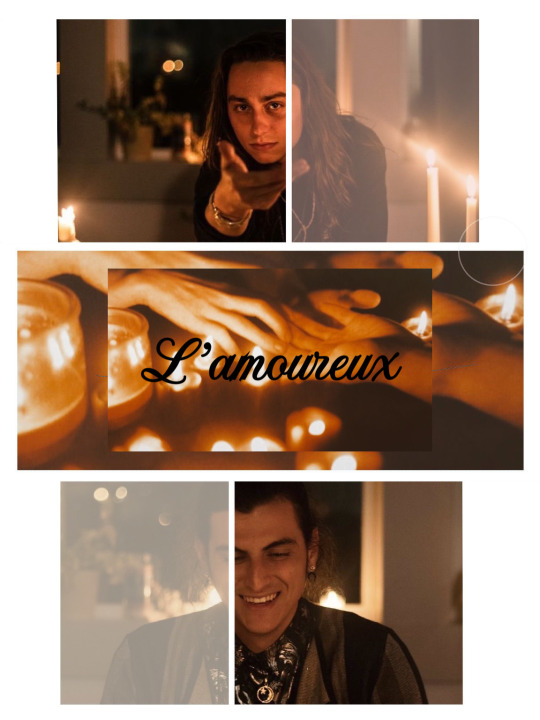
Anyone miss angsty Janny? Well I’m back! Part 3!
Pairing: Jake Kiszka X Danny Wagner *slash
Warnings and tags: 18+ only please, angst, mentions of potential panic attacks, power outage, avoidance of feelings, again just one kiss
Word count: 1.9k
“That was good, lets try it like that again” Jake instructed, readjusting his position on the small wooden stool before effortlessly placing his hands back on his acoustic. Danny counted off a quick numbered cadence to establish the tempo, then with each limb in motion started a steady rhythmic beating on his drums.
“Yeah, I’m loving that keep going” Jake continued his strumming as Danny added a few little additions to his playing as well. They jammed for a few minutes, extending the part they were supposed to be working on by a good few measures without any care. Jake closed his eyes and he softly swayed at an angle from where one of his feet remained planted firmly on the floor, and the other kicked up and relaxed on the stool. Danny’s own eyes wandered from the black dots stuck to his drum heads over to the man next to him.
It had been a few weeks since Halloween night, and although Jake wasn’t purposefully trying to ignore Danny or anything, he also hadn’t been looking for ways to be alone with him either. At least that was until today. Josh and Sam were upstairs with their producer working in a different studio room to record some vocals for the new record. That left the drummer and the guitarist to their own accords.
Jake had suggested what to focus on while it was just the two of them. A softer, gentle, and very emotional bridge that Jake had yet to perfect himself because it was “just missing something”. Danny wasn’t sure what he had done but somehow, maybe with just his company a constant beating reassurance, Jake was finally able to put the once intangible vision of what he was trying to say with his instrumental voice to near words.
When the playing slowly faded, Jake opened his eyes again with a warm excited smile and quickly moved to set his guitar down so he could scribble into his sheet music before he forgot what magic had just happened here.
“Well, you think the others are going to finish that quickly?” Danny questioned with a chuckle as he crossed his sticks over the snare drum and slowly stood up to stretch.
“Knowing Josh? No way” Jake played along, stepping back to take a look at his penciled in marks, his head nodding slightly as he played it over in his mind again.
“I mean, usually I last a little longer you know” Danny added, taking his joke in another direction entirely, “but if we work that well together then”. When Jake finally looked up from his page with wide eyes, Danny just smiled mischievously and shrugged.
“What the fuck are you even saying Wagner?” Jake cocked a challenging eyebrow. It wasn’t uncommon for either of them to make quips, even of the sexual nature, at each other. Before Jake might have come back at Danny with something witty only to dissect the entire interaction by himself later. This time he kept quiet though, almost as if he was waiting for Danny to do something to back up his claim.
A few seconds of silence settled in the rather small room they had chosen to work in today, both Jake and Danny refusing to be the first one to break eye contact until a loud crack of thunder penetrated the sound proof walls of their enclosure and all the power abruptly went out.
“Oh shit, I didn’t even know it was raining out” Danny quickly tried to assess the damages to the recording equipment, but with there being no windows in the room it was nearly pitch black. Before he could stumble over something expensive, Jake flipped his cell-phone flashlight on and clamored over toward the door.
All it took was for one failed turn of the handle for all of the blood to drain from Jake’s face. “It’s locked”.
He wasn’t actually surprised it was locked, in fact his suspicion was the reason he had hurried to check the door first. All of the recording rooms had electromagnetic locks on them. The storm cut the power so they should have automatically come unlocked, but maybe for security reasons they ran off some sort of backup power.
“This is ridiculous!” Jake shouted in rampant frustration as he tugged harder at the heavy door. It was no use, they were stuck, and he had already glanced down to see his cell reception was also gone.
”What if there were a fire or something? We would get roasted alive in here!” Instead of continuing to try the handle Jake resorted to just pounding his fists on the door, hoping his brothers had managed to make it down the stairs when the lights went out.
”Hey, hey calm down you’re going to hyperventilate” Danny tried to calm his friend, but he could hear Jake’s breathing intensify. “Come here”.
With one hand under his arm and the other grabbing his hand to spin him around, Danny pulled Jake into a tight hug in the dark. “We’re going to be okay. You’re going to be okay, I’m right here with you”.
Jake’s breath steadily began to even out again but with their extremely close proximity now Danny could feel his heart rate pick up even faster than it already was, though not from panic. He leaned back, the hand that had come to rest as a comforting weight on Jake’s back came around to cup his face. Danny’s long fingers sprawled across Jake’s jaw with feather light touch, like spider’s legs that stuck to smooth surfaces.
“Danny-” Jake whispered. Even if no one could hear them while in this room together, he still felt like his speaking voice would be too much for this unexpected instance they’d found themselves in.
“Hmm?” Danny didn’t even bother with words, his voice coming out in an even quieter hum that vibrated like a single note played in the acoustic room just as their instruments had earlier. His fingers continue to explore Jake’s face. They traced hair-thin webs across his features, making the skin prickle and the blood rush to the surface to compensate for the sensation.
Just like in his bedroom, Jake found himself caught up in Danny’s overwhelming presence. His body radiated heat like a furnace, and Jake clung to it for solace. His scent swirled around in his nostrils as he took a deep steadying breath. The smell of Danny’s cologne and hair products sticking out the most, but with hints of his own natural musk still seeping through.
Something came over Danny again, an urge he’d never felt before that night spent in Jake’s bedroom, and one he hadn’t had much success in overcoming as of yet. Danny dipped his head down, the tip of his nose brushing against Jake’s cheekbone first guiding him towards the correct place to press his lips into a kiss. Jake’s previously tense form immediately went slack in Danny’s arms and he had to cling to his shoulders to stay upright.
Danny wasn’t quite sure where he was going with this second ever kiss with Jake. He hadn’t thought about what he would do if he found himself kissing Jake again, which was rather ignorant on his part considering he hadn’t much stopped himself from thinking about the first one. Danny laid in bed nearly every night and as soon as he closed his eyes he always found himself back in that moment, thinking, dreaming, about what it would have been like if he’d just allowed himself to go further-
Well, his dreams were becoming an unanticipated reality as Jake didn’t instantly pull away from the connection, and Danny parted his lips and tightened his grip. The pads of his fingertips dimpled into Jake’s cheek as he tilted his head and Jake let out a small plaintive whine as Danny’s teeth grazed his bottom lip.
Afraid his inadvertent action had hurt Jake, Danny pulled away, glowing eyes searching through the dark as his mind scrambled for a way to excuse his misstep. Jake wasn’t having it though, he wrapped his hand around the back of Danny’s neck and took a step closer, pressing their bodies together as their lips touched again. It was featherlight at first, until Jake’s tongue slipped out and Danny willingly opened his mouth to allow him in.
Jake didn’t taste like he would have guessed, mostly because he didn’t expect it to ever come to this so he hadn’t really taken the time to ponder the possibilities. There wasn’t one singular familiar taste Danny could pinpoint alone, but more like a combination of the morning’s mouthwash lingering behind, the afternoon's lunch which he remembered was a BLT from the shop around the corner, and overall just Jake’s natural saliva mingling with his own. It should have weirded him out thinking about it, but instead Danny pressed his tongue inside further, chasing more. His hand which had slipped from Jake’s cheek now clung to his side, tugging at the open front of his flannel.
If he could rid Jake of the extra piece of pesky outerwear he usually preferred to wear in the icy studio rooms, he would, but before Danny’s hand could move into action the lights suddenly came back on.
The both of them had the same reaction, taking a step back and separating like they were two positive ends of a magnet that had gotten too close together. Jake cleared his throat as he pulled the one side of his flannel back up over his shoulder- apparently Danny had managed to pull it off some. Danny’s palms still felt clammy, and he could feel a cooling gloss of spit still coating his lips, but he was stuck in a trance.
His eyes scanned over Jake’s now completely illuminated image and he watched as Jake nervously pinched at his own kiss plumped bottom lip then ran his fingers through the tousled strands of his hair. Danny was now hyper aware of every detail his friend’s body had to offer. From the way Jake’s Adam’s apple bobbed as he swallowed harshly, the way his collar bones just barely peaked out from the cut up top of his shirt. Thick silver ropes of his Atocha necklace accentuated the smooth pane of skin it decorated, then disappeared underneath the washed out cotton. Danny could imagine the pendant that hung there, and his mind easily pictured the antique coin laying against Jake’s bare chest…
“We should umm-” Danny’s voice felt hoarse as he tried to speak normally again, breaking the tension in his limbs by moving to wipe his hands off on his jeans.
“Go check on the others?” Jake finished for him.
I was going to say talk about this, Danny thought, but instead he just nodded and followed Jake towards the door.
With a now hopeful tug, the lock gave way and Jake was successfully able to pull the heavy door open. Danny reached above and held it for them, “after you”.
Jake hesitated for a moment longer, glancing over his shoulder at the small mess they had left behind. He looked like he wanted to say something more, or perhaps he wanted to turn back and stay longer. Turn the lights back out and see how much trouble they could get into, but ultimately he straightened his shoulders and continued forward.
Thanks for reading! @kultavalo @sanguinebats @jenniferkiszka @freyjalw
12 notes
·
View notes
Text
Time to ramble & store my ClassicaLoid OC and shit in this blog ✨
These are the new ones I have planned!
Arkheloids, using the old name of Classicaloids, were created by Kyougo Otowa, after he created Wagner and Dvorak. However they don’t affiliate with the Classicaloids – some have interacted with them. Some of the Arkheloids live on Debussy’s yacht, such as; Debussy, Paganini, Ravel, Satie, Boccherini, Vivaldi, and Shostakovich… accompanied by one human; Cathe, who is forced to be included on their adventures exploring.
✨ HAYDN
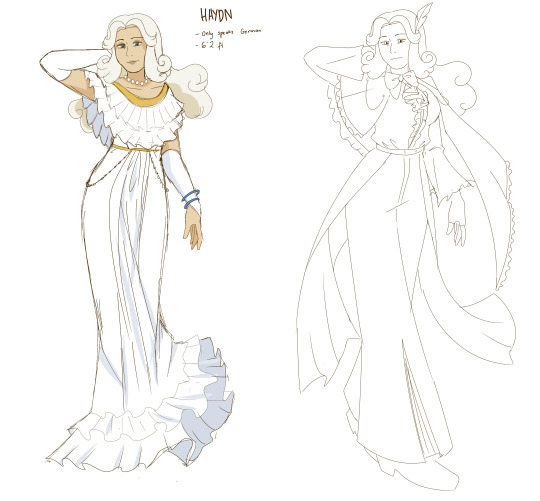
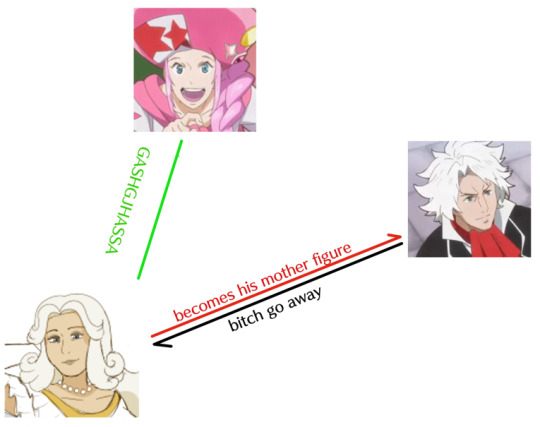
Meet Haydn who is an ArkheLoid! So far I only have colored her normal form, but I have designed her Musik form. She only speaks in German and she is a soprano singer! Haydn shows affection to everyone + Mother figure. Would listen to your problems. Always surprises her friends during their birthday. She loves to be called “Mama Haydn” if her close ones are comfortable with calling her that, it would melt her heart.
✨HANDEL
Handel is a ArkheLoid who works as a Lawyer, and he is the oldest among all of the ArkheLoids.
His eyes are sensitive to light, he wears sunglasses most of the time. Able to read people, and sometimes provide emotional support.
His Musik power is able to harmonize other Classicaloid’s Musik. This also allows him to control other’s Musik. Only he can stop everyone’s abilities. There is also another that allows him to use another Classicaloid's Musik against themselves. His transformation catchphrase is "let the cadence of my words resonate within the chambers of your soul" (In German: Lass den Kadenz meiner Worte in den Kammern deiner Seele widerhallen.)
I have no sketches or concepts yet. But I can only vision him being 6'6 ft and wears something formal/dark academia themed.
✨SHOSTAKOVICH
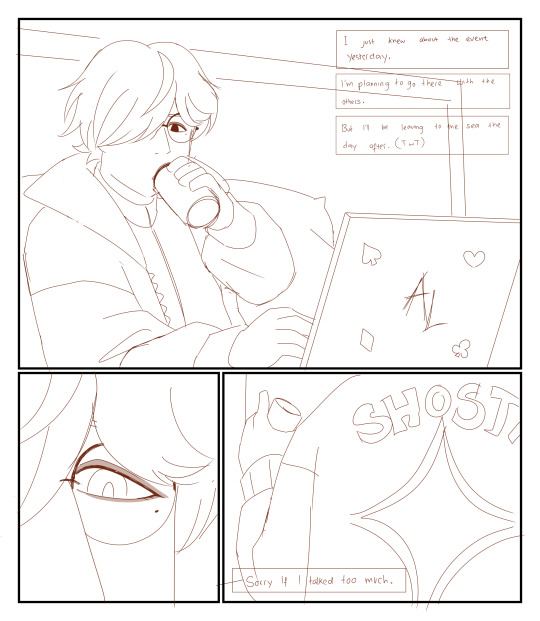
“Who the fuck is Hairy Paw Her?”
He is stoic and shy, unless you talk about soccer. No worries, he’s very polite. Occasionally, he plays card games with Boccherini. He fidgets his hands a lot, and he twitches too. Most likely to be found using a laptop to create his piece or playing games (if he's on land). Communicates with Chopin through the internet, they never saw each other in real life. They would often play online co-op games.
I have no complete reference for him yet, but I have sketched out the concept. It may change in the future.
I am currently working on a one-shot comic of him and it involves Chopin too! 16/18 pages has been sketched out and it will only be in monochrome colors, so stay tuned if you are curious to read the comic. 🕺✨
✨ VIVALDI
One hit wonder: the sequel (4 seasons).
He is an ArkheLoid with a slender and feminine body type. His hair color is dyed depending on the season he is in (mint, yellow, orange, or white color). Owns a camera, he brought it everywhere (especially when he’s traveling).
I have no concepts/sketch for him yet.
✨ANCENE CATHE
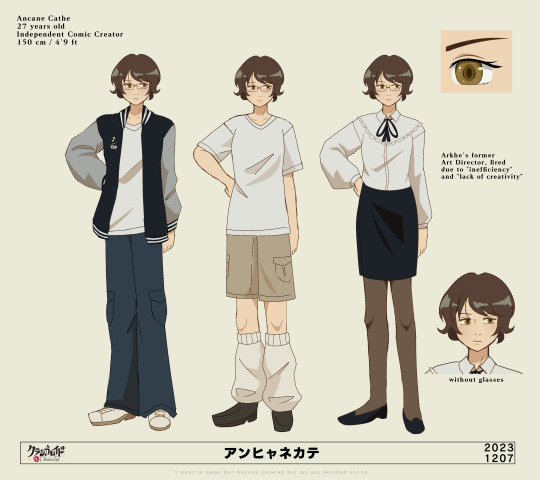
Cathe is a human who is involved with ArkheLoid's shenanigans. Before she is an independent comic creator, she worked at Arkhe's Talent Agency as an Art Director. For years working on Arkhe, she got fired due to “lack of creativity” and "inefficiency" (she intended to do that).
Cathe easily gets seasick, and she has thalassophobia. It is a challenge for her to stay in Debussy's yacht for the ArkheLoid's voyage.
✨ANZU MIZUMOTO
Anzu, who is Cathe's best friend, works at Arkhe's Talent Agency as the receptionist (night shift) -- on some occasion, she works as the canteen’s waitress. She is that person who has a crush on everyone she talks to, but her feelings towards them only last for a few days. Secretly reads smut to keep her up at her night shift. Cathe’s best friend, she also has a crush on her - and Cathe is too dumb to notice it.
I have no concepts of her yet. However, I can only imagine that she wears formal clothes (suit and skirt), appears to be taller than Cathe.
✨ OTHER OC NAVIGATION
Debussy
Paganini
ArkheLoids (OUTDATED)
29 notes
·
View notes
Text
OOR 2002 - Nr 10 - Rammstein interview



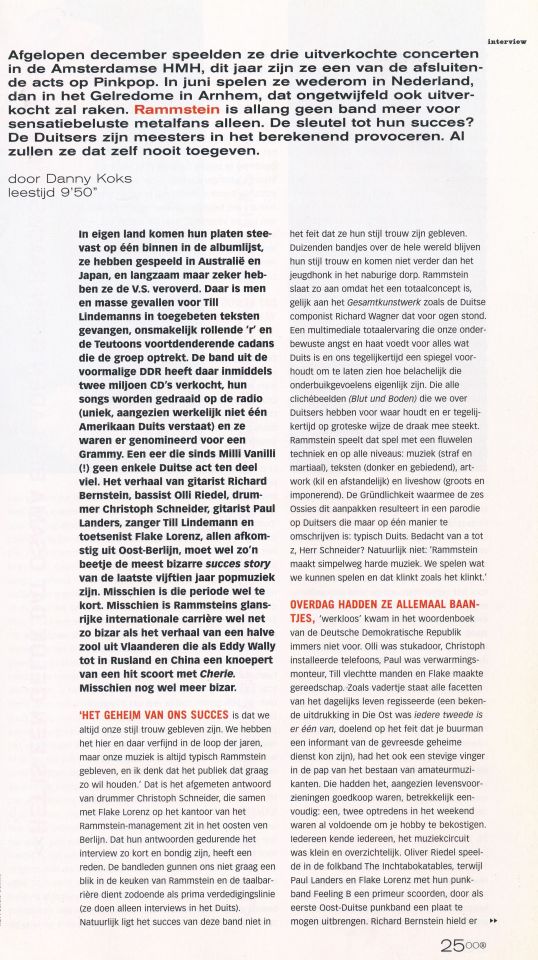
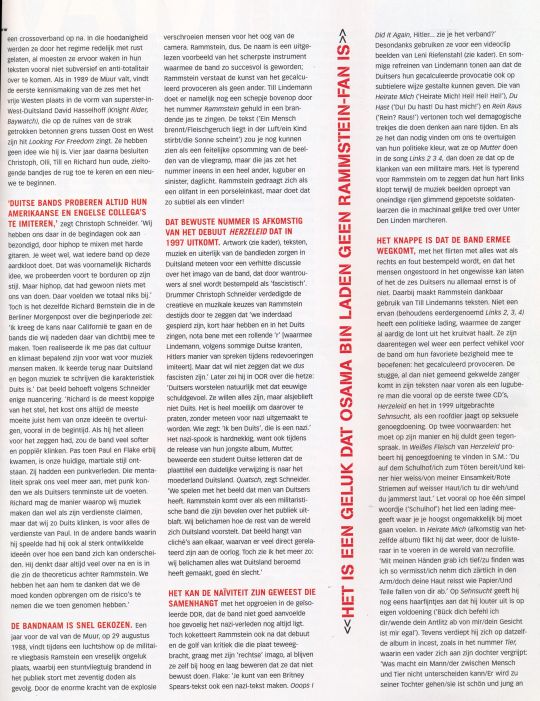

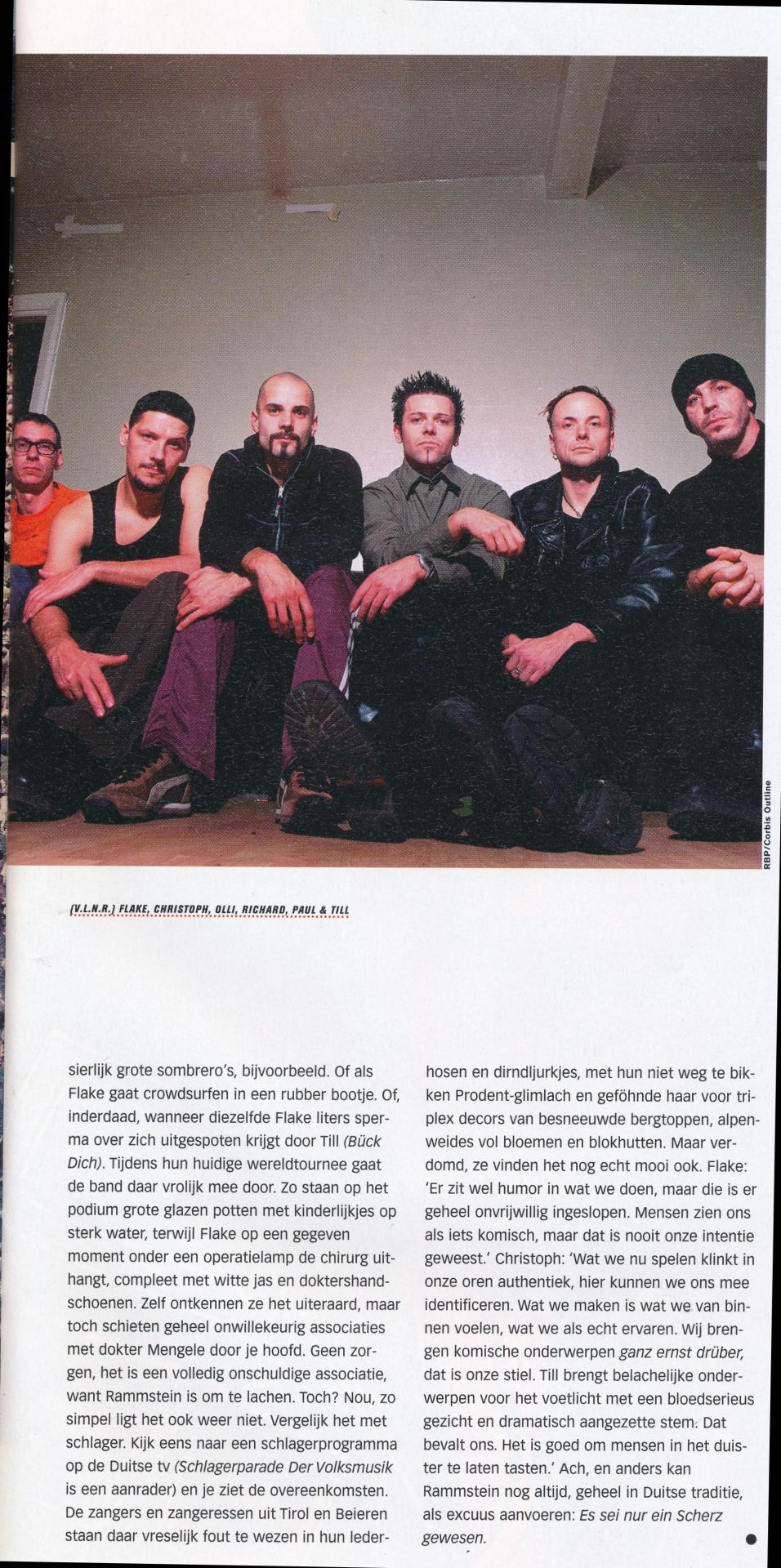
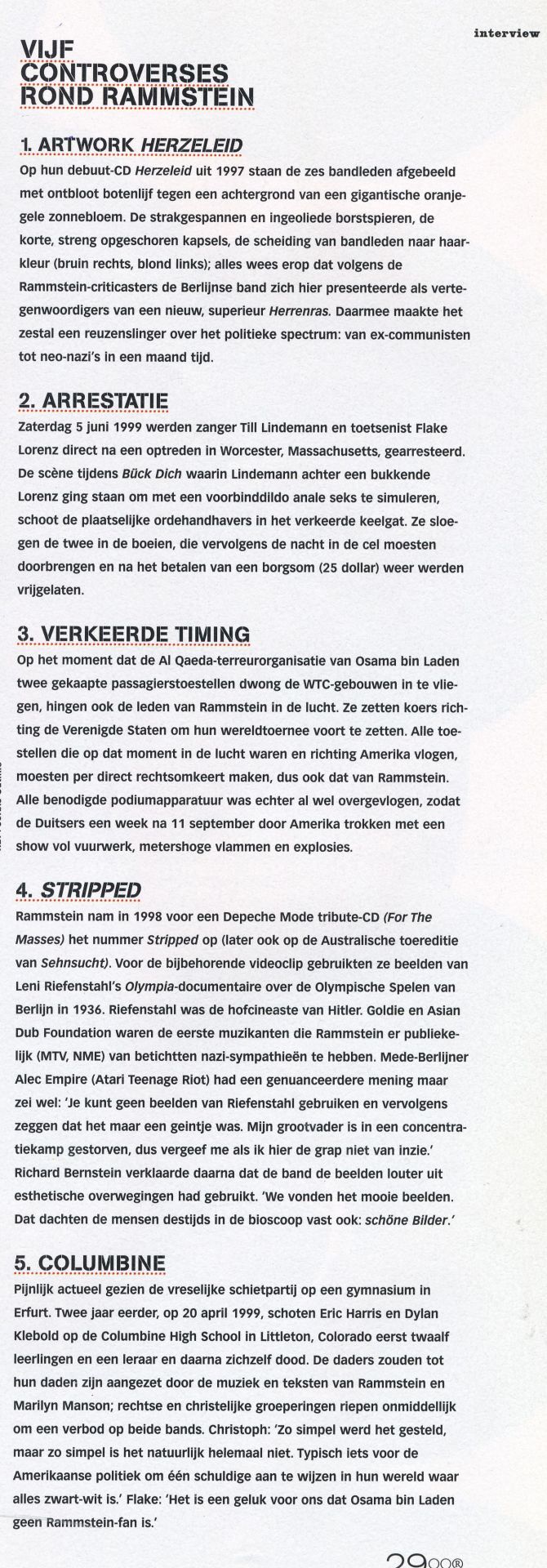
Rammstein
Last December they played three sold-out converts in Amsterdam's HMH, this year they are one of the closing acts at Pinkpop. In June they will play again in the Netherlands, at the Gelredome in Arnhem, which will undoubtedly also be sold out. Rammstein is no longer a band just for sensation-seeking metal fans. The key to their success? The Germans are masters of calculated provocation. Although they will never admit it themselves.
by Danny Koks
In their own country, their records consistently number one on the album charts, they have played in Australia and Japan, and slowly but surely they have reached the U.S. conquered. There people have fallen en masse for Till Lindemann's captured lyrics, distasteful rolling 'r' and the Teutonic thundering cadence that drives the group. The band from the former GDR has now sold two million CDs there, their songs are played on the radio (unique, since not a single American understands German) and they were nominated for a Grammy. An honor that no German act has received since Milli Vanilli (!). The story of guitarist Richard Bernstein, bassist Olli Riedel, drummer Christoph Schneider, guitarist Paul Landers, singer Till Lindemann and keyboardist Flake Lorenz, all from East Berlin, has to be the most bizarre success story of the last fifteen years. be pop music. Perhaps that period is too short. Perhaps Rammstein's glittering international career is just as bizarre as the story of a dimwit from Flanders who, as Eddy Wally 1), scored a killer hit with Cherie as far away as Russia and China. Perhaps even more bizarre.
"The secret of our success is that we have always stayed true to our style. We have refined it here and there over the years, but our music has always remained typical Rammstein, and I think the audience would like to keep it that way. " That is the measured answer from drummer Christoph Schneider, who sits together with Flake Lorenz at the Rammstein management office in eastern Berlin. There is a reason why their answers during the interview are so short and concise. The band members do not like to give us a glimpse into the kitchen of Rammstein and the language barrier therefore serves as an excellent line of defense (they only do interviews in German).
Of course, the success of this band does not lie in the fact that they have remained true to their style. Thousands of bands all over the world remain true to their style and do not go further than the youth club of the neighboring village. Rammstein is so popular because it is a total concept, similar to the Gesamtkunstwerk as envisioned by German composer Richard Wagner. A multimedia total experience that feeds our subconscious fear and hatred for everything German and at the same time holds up a mirror to show us how ridiculous those gut feelings actually are. Who takes all the cliché images (Blut und Boden) that we have about Germans as true and at the same time makes fun of them in a grotesque way. Rammstein plays that game with a velvet technique and at all levels: music (punishment and martial), lyrics (dark and commanding), artwork (cold and distant) and live show (grand and imposing). The Gründlichkeit with which the six Ossies approach this results in a parody of Germans that can only be described in one way: typically German. Thought out from A to Z, Herr Schneider? Of course not: "Rammstein simply makes loud music. We play what we can play and it sounds the way it sounds."
During the day they all had jobs, after all, 'unemployed' did not exist in the dictionary of the German Democratic Republic. Olli was a plasterer, Christoph installed telephones, Paul was a heating engineer, Till woven baskets and Flake made tools. Just as Father State directed all facets of daily life (a well-known expression in Die Ost was 'every second is one of them', referring to the fact that your neighbor could be an informant for the feared secret service), it also had a strong involvement in the existence of amateur musicians. Since living expenses were cheap, they had it relatively easy: one or two performances at the weekend were enough to finance your hobby. Everyone knew everyone, the music circuit was small and well-organized. Oliver Riedel played in the folk band The Inchtabokatables, while Paul Landers and Flake Lorenz scored a premiere with their punk band Feeling B by being the first East German punk band to release an album. Richard Bernstein had a crossover band. In that capacity, the regime left them relatively alone, although they had to be careful not to come across as subversive and anti-totalitarian in their lyrics. When the Wall falls in 1989, the six's first encounter with the free West takes place in the form of West Germany superstar David Hasselhoff (Knight Rider, Baywatch), who stands on the ruins of the tightly drawn concrete border between East and West sing his hit Looking For Freedom. They have no idea who he is. Four years later, Christoph, Olli, Till and Richard decide to turn their backs on their old, moribund bands and start a new one.
"German bands always try to imitate their American and English colleagues," says Christoph Schneider. "We did that in the early days, by mixing hip-hop with hard guitars. You know, what every band on this planet does. That was mainly Richard's idea, we tried to build on his style. But hip-hop, that just had nothing to do with us. We didn't feel anything about it at all." Yet it is the same Richard Bernstein who said about those early days in the Berliner Morgenpost: "I had the opportunity to go to California and experience the bands we imitated up close. Only then did I realize that culture and climate determine what kind of music people make. I returned to Germany and started writing music that is characteristically German." According to Schneider, that picture requires some nuance. "Richard is the most stubborn of the bunch, we always have the most difficulty convincing him of our ideas, especially in the early days. If he had the sole say, the band would sound much softer and poppier. Only when Paul and Flake joined, our current, martial style was born. They had a punk past. That mentality appealed to us much more, as Germans we could at least get along with punk. Richard wants to take credit for the way we make music, but the fact that we sound so German is above all Paul's merit. In the other bands he played in, he also had highly developed ideas about how a band can distinguish itself. He always thinks a lot about that and is in that sense the theorist behind Rammstein. We owe it to him that we were able to muster the courage to take the risks we did then."
The band name was quickly chosen. A year before the fall of the Wall, on August 29, 1988 2), a terrible accident occurs during an air show at the Ramstein military air base, in which a stunt plane crashes into the audience while burning, resulting in seventy deaths. The enormous force of the explosion scorches people in front of the camera. Rammstein, that is. The name is a prime example of the sharpest tool with which the band has become so successful; Rammstein understands the art of calculated provocation like no other. Till Lindemann goes one step further by singing the song Rammstein wrapped in a burning coat. The lyrics ('Ein Mensch brennt/Fleischgeruch lieft in der Luft/ein Kind stirbt/die Sonne scheint') could still be seen as a factual summary of the images of the air disaster, but that coat suddenly puts the song in a completely different, lugubrious and sinister, daylight. Rammstein behaves like an elephant in a china shop, but does so as subtly as a butterfly!
That song in question comes from the debut Herzeleid, which was released in 1997. Artwork (see 'controversies'), lyrics, music and appearance of the band members immediately sparked a heated discussion in Germany about the band's image, which distrusters quickly labeled as 'fascist'. Drummer Christoph Schneider defended Rammstein's creative and musical choices at the time, saying that "we are indeed muscular, have short hair and sing in German, with a rolling 'r' (with which Lindemann, according to some German newspapers, imitates Hitler's way of speaking during speeches). But that does not mean that we are fascists." Later he said in OOR about this smear: "Germans of course struggle with that eternal feeling of guilt. They want to be everything, but please not German. It is very difficult to talk about that without immediately being called a Nazi. Who says: 'I am German', he is a Nazi." The Nazi ghost is persistent, because even during the release of their latest album, Mutter, a student of German literature claimed that the record title is a clear reference to the mother country Germany. Quatsch, says Schneider. "We play with the image people have of Germans. Rammstein comes across as a militaristic band that barks its orders at the audience. We embody how the rest of the world imagines Germany. That image is made up of clichés, many of which are directly related to the war. Yet I see it more like this: we embody everything that has made Germany famous, good and bad."
It may have been the naivety associated with growing up in the isolated GDR that prevented the band from properly sensing how sensitive the Nazi past still is. Yet even after that debut and the wave of criticism that album provoked, Rammstein likes to flirt with his 'right-wing' image, although they continue to claim that they do not do this consciously. Flake: "You can also turn a Britney Spears lyric into a Nazi lyric. Ooops I Did It Again, Hitler...do you see the connection?"
Nevertheless, they use images of Leni Riefenstahl for a video clip (see 'controversies'). And some of Lindemann's choruses show that the Germans can also express their calculated provocation in a more subtle way. Those of Heirate Mich ('Heirate Mich! Hei! Hei! Hei!'), Du Hast ('Du! Du hast! Du hast mich!') and Rein Raus ('Rein? Raus!') do show demagogic traits that are reminiscent of bad times. And when they feel it necessary to convince us of their political color, which they do on Mutter in the song Links 2 3 4, they do so to the sounds of a military march. It is typical of Rammstein to say that their heart beats on the left while the music conjures up images of endless rows of shiny, polished soldiers' boots marching in mechanical step across Unter Den Linden.
The great thing is that the band gets away with flirting with everything that is labeled as rightwing and wrong, and that it can leave people in the dark undisturbed as to whether the six Germans are all serious or not. Rammstein makes grateful use of Till Lindemann's texts. Not one of them (except for the aforementioned Links 2, 3, 4) has a political connotation, with which the singer defuses the situation. On the other hand, they are a perfect vehicle for the band to practice their favorite activity: calculated provocation. The surly, possibly or not genuinely tormented singer emerges in his lyrics as a lugubrious man who, especially on the first two CDs Herzeleid and the 1999 released Sehnsucht, hunts for sexual satisfaction like a predator. On two conditions: it has to be his way and he will not tolerate any objection. In Herzeleid's Weisses Fleisch he tries to find satisfaction in S.M.: 'Du auf dem Schulhof/ich zum Töten bereit/Und keiner hier weiss/von meiner Einsamkeit/Rote Striemen auf weisser Haut/ich tu dir weh/und du pity laut.' Pay particular attention to how one simple word ('Schulhof') gives the song a charge that makes you feel extremely uncomfortable. In Heirate Mich (from the same album) he does this again, by introducing the listener to the world of necrophilia. 'Mit meinen Händen grab ich tief/zu finden was ich so vermisst/ich nehm dich zärtlich in den Arm/doch deine Haut reisst wie Papier/Und Teile fallen von dir ab.' On Sehnsucht he once again explains in detail that he is purely interested in his own satisfaction ('Bück dich befehl ich dir/wende dein Antlitz ab von mir/dein Gesicht ist mir egal'). On the same album he also delves into incest, such as in the song Tier, in which a father sexually assaults his daughter: 'Was macht ein Mann/der zwischen Mensch und Tier niet unterscheiden kann/Er wird zu seiner Tochter gehen/sie ist schön und jung an Jahren/Und dann wird er wie ein Hund/mit eigen Fleisch und Blut sich paaren'. From Speil Mit Mir the following stanza: 'Wir teilen Zimmer und das Bett/Brüderlein komm und sei so nett/Brüderlein komm fass mich an/rutsch ganz ganz dense an mich heran.' Mutter deviates from his predecessors in that Lindemann seems to have moved on from his sexual perversions, except for the song Rein Raus: 'Tiefer tiefer/sag es sag es laut/tiefer tiefer/ich fühl mich wohl in deiner Haut.' The provocation is now found through other channels, such as in the song Ich Will, which, given the earlier accusations of fascist tendencies, has a strikingly popular character: 'Wir wollen dass ihr uns vertraut/wir wollen dass irh uns alles glaubt/Wir wollen eure Hand sehen/wir wollen in Beifall untergehen.' Of course, shivers run down your body when Lindemann cuts Snow White into a morbid fairy tale (Mein Herz Brennt): 'Nun liebe Kinder gebt fein eight/ich bin die Stimme aus dem Kissen/Ich hab euch etwas mitbracht/hab es aus meiner Brust geissen. '
"Pain, suffering and heartbreak have always been a source of inspiration for us," says Christoph Schneider about the lyrics. "When we started the band, we all had relationship problems, some of us even had to leave our children. At that time, music was an outlet for our frustrations for all of us. Ten years have passed and for me personally, suffering plays no role in my life anymore, but for Till it absolutely does. And there are a few band members who have to be in a constant state of pain and sadness in order to feel good. Although I do think that we will slowly have to break new ground if Rammstein is to continue to exist." So to think that the band has become more cautious is a wrong assumption? "Yes, we have always played with ambiguity. In the very beginning we just tried everything. Until we heard the public reactions: 'Can a band make something like that, isn't it all too German?' Should we explain everything or leave our image open without providing any text or explanation? We opted for the latter. This action-reaction dynamic is something we have been dealing with for years now, with public criticism serving as an indicator: If people think we are going too far, then we know we are doing the right thing. Furthermore, it is a matter of remaining brave and saying: Was die Leute finden ist mir scheiss egal. Still, I think we have closed a phase with Mutter. We can't continue to flirt with taboo themes, we have already pushed the boundaries of that."
The fact that Rammstein can cut so undisturbed with his sharpest knife (provocation) is due to their most blunt instrument: the live show, in which they perform a modern variant of Dante's inferno as post-apocalyptic half-zombies. During the Sehnsucht tour, the band members appeared as robots and machines. Their hair is dyed silver, with long coats full of nail studs and rubber and bright blue lenses. Cold and expressionless, they stared into the crowd. Till Lindemann descended onto a trapeze staircase, while jets of fire sparkled from beneath him. he carried flamethrowers shaped like Freddie Krueger fingers. His voice rolled over the audience like a Teutonic march: punishing and unrelenting. He punished himself with a whip, and a little later, using fire-breathing boots, he rolls over cartwheels across the stage. Deep red blood seeped from his silver hair. A woman in angelic robes descended into a rusted steel cage, while flames spouted meters high into the air around her.
The band manages to convey all this with so much seriousness that the few moments in which Rammstein allows you to think that you might also find it all very funny have an even more alienating effect. When the two guitarists and the bassist enter the stage during Wilder Wein with ridiculously large sombreros, for example. Or when Flake goes crowd surfing in a rubber boat. Or, indeed, when the same Flake gets liters of semen sprayed over him by Till (Bück Dich). The band continues to do so happily during their current world tour. For example, large glass jars containing children's corpses are placed on stage in strong water, while at one point Flake appears to be a surgeon under an operating lamp, complete with white coat and doctor's gloves. They themselves of course deny it, but associations with Doctor Mengele still pop into your head completely involuntarily. Don't worry, it's a completely innocent association, because Rammstein is fun. Isn't it? Well, it's not that simple. Compare it to schlager. Watch a schlager program on German TV (Schlagerparade Der Volksmusik is highly recommended) and you will see the similarities. The singers from Tyrol and Bavaria look terribly out of place in their lederhosen and dirndl dresses, with their undeniable Prodent 3) smile and blow-dried hair in front of plywood sets of snow-capped mountain peaks, alpine meadows full of flowers and log cabins. But damn, they still really like it. Flake: "There is humor in what we do, but it has crept in completely involuntarily. People see us as something comical, but that has never been our intention." Christoph: "What we are playing now sounds authentic to our ears, we can identify with this. What we make is what we feel inside, what we experience as real. We bring comedic subjects with complete seriousness, that is our craft. Till brings ridiculous topics into the spotlight with a deadly serious face and dramatically accented voice. We like that. It's good to keep people in the dark." Oh well, otherwise Rammstein can still use the excuse, entirely in German tradition: Es sei nur ein Scherz gewesen.
Five controversies surrounding Rammstein
1. Artwork Herzeleid
On their debut CD Herzeleid from 1997, the six band members are depicted bare-chested against a background of a gigantic orange-yellow sunflower. The taut and oiled chest muscles, the short, severely shaved haircuts, the separation of band members by hair color (brown on the right, blond on the left); everything indicated that, according to the Rammstein critics, the Berlin band presented itself here as a representative of a new, superior Men's race. With this, the six made a giant swing across the political spectrum: from ex-communists to neo-Nazis in the space of a month.
2. Arrest
On Saturday, June 5, 1999, singer Till Lindemanne and keyboardist Flake Lorenz were arrested immediately after a performance in Worcester, Massachusetts. The scene during Bück Dich in which Lindemann stood behind a bending Lorenz to simulate anal sex with a strap-on dildo, rubbed local law enforcement officers the wrong way. They handcuffed the two, who then had to spend the night in jail and were released after paying bail (25 dollars).
3. Wrong timing
At the moment Osama bin Laden's Al Qaeda terror organization forced two hijacked passenger planes into the WTC buildings, Rammstein's members were also in the air. They set course for the United States to continue their world tour. All aircraft that were in the air at that time and flying towards America had to immediately turn around, including Rammstein's. However, all the necessary stage equipment had already been flown over, so a week after September 11, the Germans toured America with a show full of fireworks, meter-high flames and explosions.
4. Stripped
Rammstein recorded the song Stripped in 1998 for a Depeche Mode tribute CD (For The Masses) (later also on the Australian tour edition of Sehnsucht). For the accompanying video clip they used images from Leni Riefenstahl's Olympia documentary about the Berlin Olympic Games in 1936. Riefenstahl was Hitler's court filmmaker. Goldie and Asian Dub Foundation were the first musicians to publicly accuse Rammstein (MTV, NME) of having Nazi sympathies. Fellow Berliner Alec Empire (Atari Teenage Riot) had a more nuanced opinion but did say: "You can't use Riefenstahl's footage and then say it was just a joke. My grandfather died in a concentration camp, so forgive me if I here don't see the joke." Richard Bernstein subsequently stated that the band had used the images purely for aesthetic reasons. "We thought they were beautiful images. That's probably what people in the cinema thought at the time: beautiful images."
5. Columbine
Painfully topical given the terrible shooting at a gymnasium in Erfurt. Two years earlier, on April 20, 1999, Eric Harris and Dylan Klebold shot and killed twelve students and a teacher and then themselves at Columbine High School in Litteleton, Colorado. The perpetrators are said to have been incited to their actions by the music and lyrics of Rammstein and Marilyn Manson; right-wing and Christian groups immediately called for a ban on both bands. Christoph: "It was put that simply, but of course it is not that simple at all. Typical of American politics to point to one guilty party in their world where everything is black and white." Flake: "It's fortunate for us that Osama bin Laden is not a Rammstein fan."
--
1) Eddy Wally was a Belgian singer who enjoyed some popularity among 'regular' folks, but to 'critical music journalist' made pretty much the epitomy of 'tacky' music. Being Belgian is for some Dutch a source for ridicule in itself.
2) Nitpicking but the airshow disaster in Ramstein took place on August 28 (not 29) 1988
3) Prodent is big brand of toothpaste in the Netherlands
--
List of other Rammstein OOR interviews
25 notes
·
View notes
Text
Elsbeth (1.08) Reactions:
Spoilers under the cut!
Elizabeth Lail!!! My first exposure to her was when she played Anna in OUAT.
(Oh, OUAT. ☠️)
“I would have never walked home alone after the One Direction concert.” WOQOQKDJW, that is such an insanely funny line.
Ooh, her recording her meeting to try and give herself an alibi! Fun.
DEATH BY CATTLE PROD!!
Omfg at Elsbeth eating a tomato like that and Kaya having to save her from the bougie co-op.
THE TOMATO COSTING $12.
Oh, Detective Edwards again! Yeah, really liking the detectives starting to recur. It’ll be fun to track their various relationships with Elsbeth over time.
Elsbeth: “I prefer a little color.” gay
Quinn is such a horrible liar, lol. And there’s something so pretentious and artificial about her cadence, which is precisely the point.
I love the & ELSBETH plaque beneath STORAGE CLOSET.
“We need to be perfect to be trusted.” Great commentary on the way that race plays into the scrutiny that Wagner and his wife are constantly under. They can’t afford to make even the simplest mistake because they’re Black, and Wagner knows the public won’t be forgiving. So fucking upsetting.
I think it’ll be boring if Lt. Noonan ends up being the sole culprit behind the Flair-All thing.
At this point in the season, I’m pretty sold on Wagner not really being involved (mainly because he’s Wendell Pierce and they’re not getting rid of him, lmao). And it sounds like Noonan is def. involved, but I don’t buy that he’s the mastermind just yet.
Kaya, Elsbeth, and Wagner all laughing together at Edwards is everything yjrkfjdn.
Good on the show for tackling some of the dangers of AI.
“Ooh, a challenge. How fun!” goddamn, I love when Elsbeth is passive aggressive.
Elsbeth apparently ruining her washer by tie-dyeing all her socks one winter.
Elsbeth playing with the toy AKAKAKSJA. God, she’s so wonderfully ADHD coded.
AND NOW SHE’S RIDING A SCOOTER!!
Elsbeth @ Kaya: “I love it when you notice things.” <33
A subtle and lovely development—Kaya has been much more proactive about investigating than she was at the start of the season—clearly more confident in her abilities and power to take initiative. I love that for her.
“I don’t know why it turned out so green.” JESUS DMSKDNSNDN
my god, I love Elsbeth’s little bucket hats.
Watching Elsbeth getting into culprits’ physical space each episode is so much fun. It’s absolutely a psychological power move.
Kaya: “I’d love to, but I got a new couch.” Gdjdjdjdj
ELSBETH ADOPTING THE DOG!!! AUGH
Elsbeth’s kitchen is gorgeous. Love that blue.
That floral blazer and pink shirt!!!
Elsbeth using the cane to simulate the murder via cattle prod AKSKSKSN
“Oh, um, well, you might need this then.” [Elsbeth hands Quinn the cane.] STONE COLD!!!!!!!!!!
Hm, my first impression is that this ep. was def. not my fave of the season, but it was cute!
8 notes
·
View notes
Text
Radix Nationals Predictions
Mini
Top 30: Asha Lee, cadence zuehlke, prestige ball, xiamya reed, Collette Stutzman, Elliana Cain, Liv Matson, Everly Hafey, Ricki Dixon, Melissa Kerr, Lillian Simonton, Ellie Flory, Arianna Claxton
Top 15: Abby Rodriguez, Mila Hiatt, Gemma holmes, brielle arias, kenly carver, Katie Carlson, Sofia Cuevas, Kennedy truax, Zoey Martinez, aliya rothe, Chloe todman
Top 6: Stella Brinkerhoff, mikayla isler, Payton jetson, aspen Brandt, Charlotte rathjen, melina biltz, mila renae
(I put seven because not sure if Stella is competing)
Junior
Top 30: Aracely Lee, Lyla norby, Rissa Laguana, khloe kwon, braydon Ziegler, Ella Carlson, addilyn Sullivan, aria bongiorno, Kate matthews, patience Hughes, Talia mempin, Zoey claxton, alivya neeriemer, violet mcguire
Top 15: piper Perusse, Francesca Jen, melania khait, Brooklyn ward, sarahi Lopez-prieto, tayah klimuck, devyn scherff, greta Wagner, Tabitha nan, skyla lucena
Top 6: Kennedy Anderson, Emily polis, brynn jones, mika takase, addyson paul (used to have camila but need to update now)
Teen
Top 30: Maddie De Dios, teegan moylan, madyson Likovic, Isabella Pham, Annie Carlson, Kylee ngo, Vanessa soto, Ellie Brunson, Jackson rueckert, sky auerbach, Cade kaiser, Halle hunt, Allison Shin, Natalie Galla, Jonah Gardner, Skylah tsang
Top 15: Emmy Claire kaiden, Sloane Dawson, gave Davis, Leighton curry, Lexi Godwin, Alexis Mayer, Sophia schiano, Zachary Gibson, Paige dimos
Top 6: Coltrane vodicka, Riley Ziegler, kinsley oykhman, Georgia Beth Peters, Caitlyn Polis, Aaliyah Dixon
Senior
Top 30: Rosendo Arechiga, lily godwin, Louise hindsbo, Kylee Amoroso-Kawamoto, Camryn lanigan, Madison polis, lily roundtree, jordyn Cocozello, Molly Johnson, Alexis Olson, grace McKinley, Eva Chapelle, Piper Cann, Kendall Birnbaum, Olivia Pinon, Isabella Gomez, Darbye Simpson, Georgi Arnold
Top 15: Alexis Ahn, kaylinn Rees, Madison marshall, Alexis Schuller, lily Goehring, Logan Marumoto-Kaleimamahu, Audrey La France, T Amari, Aaliyah Landreaux, Kaitlyn Allen
Top 6: Angelika Edejer, Jordyn Green, Kenzie Jones, Sabine Nehls, Vadriana Romero, Iliana Victor
2 notes
·
View notes
Text
Echoes from the Shadows: A Deep Dive into Rare Gothic Horror Operas
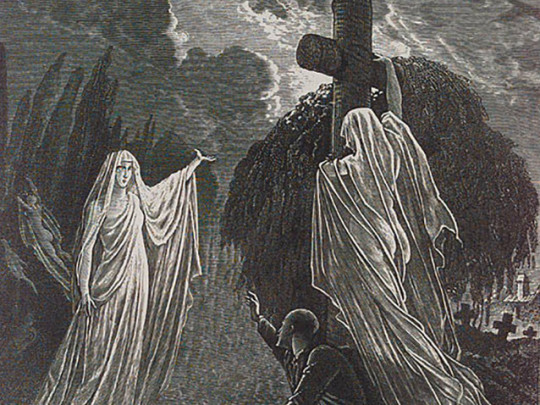
Opera has long served as a vehicle for emotional extremity and theatrical grandeur. Yet hidden within its repertoire lies a lesser-known corridor—where the supernatural, the grotesque, and the psychologically unhinged reside. Gothic horror operas, often overlooked or misunderstood, deploy music as a visceral language of dread and delirium. This essay explores ten such works, rare yet resonant, where the boundaries between music and madness blur, and where composers twist form, harmony, and timbre to evoke the uncanny.
1. Charles Gounod – La Nonne Sanglante (1854)
This early Gothic opera is a masterclass in Romantic atmosphere. Structurally, Gounod adheres to traditional forms—arias, duets, ensembles—but infuses them with chromatic ambiguity and eerie orchestration. The titular ghost nun is often preceded by modulations into remote keys and the use of tremolo strings, low brass, and dark woodwinds (notably the bass clarinet), creating spectral sonorities. In the ghost’s key scenes, Gounod abandons lyrical melody in favor of declamatory, syllabic writing, increasing dramatic tension. Cadences are often obscured or delayed, suspending the music in dread. Though rooted in Meyerbeerian grand opera, La Nonne Sanglante leans more toward psychological horror than spectacle.
2. Gaetano Donizetti – Maria de Rudenz (1838)
A deviation from Donizetti’s more luminous works, this opera is structurally daring. The overture introduces a doom-laden motif in the cellos that reappears at key psychological breaks. Donizetti uses unusual key juxtapositions to highlight Maria’s unraveling mind—modulating abruptly from A minor to F-sharp minor, or inserting diminished chords mid-phrase to destabilize expectations. The Act II finale is a virtuosic example of building tension through obsessive rhythmic ostinati, especially in the lower strings. Donizetti also plays with silence: brief pauses between Maria’s lines, accompanied by pizzicato or tremolo strings, function almost like cinematic jump cuts, heightening suspense.
3. Heinrich Marschner – Der Vampyr (1828)
This early German Romantic opera precedes Wagner, but hints at his innovations. Marschner uses recurring motifs—proto-leitmotifs—to signal Ruthven’s vampiric nature. A descending minor-third motif, played by horns and cellos, accompanies his entrances and appears subtly even when he is merely spoken about. The orchestration emphasizes shadowy colors: muted strings, low woodwinds, and organ-like harmonies in the trombones. Structurally, the opera alternates between strophic arias and through-composed scenes, with dramatic recitative seamlessly integrated. Choral writing plays a large role, with villagers’ choruses often employing modal harmonies to contrast the tonal corruption Ruthven brings.
4. Louise Bertin – Le Loup-Garou (1827)
Though rarely performed, Bertin’s chamber opera stands out for its harmonic daring. The transformation scenes feature layered diminished seventh chords and augmented sixths, not as moments of modulation, but as destabilizing textures. Bertin experiments with form: the werewolf’s aria eschews a regular ABA pattern, instead fragmenting into shorter phrases with sudden tempo shifts. She favors unusual instrumentation—harp glissandi and col legno strings—to evoke the wildness and mystery of the forest. Bertin also employs thematic inversion to represent dual identity, musically mirroring the protagonist’s human and animal natures.
5. Ben Frost – The Wasp Factory (2013)
Frost’s opera deconstructs traditional operatic form entirely. Scored for electronics, ambient textures, and amplified voice, it employs a post-minimalist aesthetic laced with industrial noise. Instead of arias or recitatives, vocal material is delivered in short, fragmented statements, often electronically processed. Harmonic stasis dominates: drones in microtonal clusters form the bedrock over which glitch-like rhythms stutter. Rather than modulate, Frost thickens or strips back the texture to signal narrative development. The vocal writing is non-linear; the three female voices often overlap or echo each other, representing the protagonist’s fractured psyche rather than discrete characters.
6. Guiraud / Saint-Saëns / Dukas – Frédégonde (1895)
This tripartite opera showcases three distinct compositional voices. Guiraud’s Act I is traditional in form but rich in chromatic counterpoint. Saint-Saëns’ Act II employs dense orchestration, with brass fanfares and contrapuntal fugatos giving a sense of martial rigidity. Dukas’s contribution is the most harmonically advanced—he manipulates whole-tone scales, tritone relationships, and quartal harmonies to convey instability and psychological ambiguity. The musical architecture is episodic, reflecting the segmented authorship, but unified by recurring rhythmic motifs—short-short-long figures—that represent Frédégonde’s obsession and cruelty.
7. Philip Glass – The Fall of the House of Usher (1987)
Glass’s opera adapts Poe’s tale with minimalist rigor. The score is built on arpeggiated cells—often in minor modes—that repeat with gradual variation, giving a sense of claustrophobic inevitability. Harmonic shifts occur subtly over long spans, creating a slow, inexorable descent into madness. The vocal lines are rhythmically fixed and speech-like, yet emotionally detached, mirroring the characters’ decay. Structurally, Glass avoids traditional climaxes: the opera functions as a psychological spiral, circling ever closer to collapse. The orchestration is lean, often just strings and keyboard, reinforcing the sense of isolation within the Usher mansion.
8. Erich Wolfgang Korngold – Die tote Stadt (1920)
Korngold’s post-Romantic score is symphonic in scale and cinematic in its emotional sweep. His harmonic language, steeped in late Mahler and early Strauss, uses chromatic saturation and enharmonic modulation to create dreamlike ambiguity. Leitmotifs are central: the “Marietta’s Lied” melody recurs in distorted forms, reflecting Paul’s hallucinations and obsession. The opera’s dramatic structure is built around a central dream sequence, with music shifting from lush tonality to expressionist dissonance and back again. Orchestral interludes act as psychological bridges, giving voice to Paul’s inner world. Few operas match its balance of sensual beauty and creeping dread.
9. Bohuslav Martinů – Larmes de Couteau (1928)
This surrealist one-act opera is formally experimental, with jazz-inspired syncopation and rapidly shifting time signatures. Martinů employs collage techniques: whole-tone passages suddenly give way to diatonic waltzes, then dissolve into Sprechstimme. The structure resists conventional scenes or arias, instead unfolding like a cabaret revue with absurdist irony. Orchestrally, he favors bright, brittle textures—piccolo, xylophone, muted trumpets—clashing against moments of grotesque lyricism. The “tears of knives” motif appears as a descending chromatic fragment, distorted each time it returns. The opera’s finale—a mock funeral march with slapstick rhythms—blurs comedy and horror in a way that’s both disorienting and brilliant.
10. John Harbison – Full Moon in March (1977)
Harbison’s atonal opera is spare and ritualistic. His compositional technique involves pitch-class sets and non-functional harmony, creating a sonic world of stark abstraction. The vocal writing is angular, with wide intervals and whispered passages that verge on extended technique. The instrumentation is minimal: often just percussion, strings, and flute, with prepared piano adding percussive color. The opera’s form follows a ritual structure—recitative, dance, sacrifice—rather than a dramatic arc. Harmonic stasis dominates, with transformation occurring via timbral evolution rather than tonal progression. Silence is integral: entire scenes are built around tension between sound and its absence, reinforcing the opera’s meditative dread.
Conclusion
These ten operas, each unique in their approach, reveal how composers across eras have manipulated musical language to evoke horror, anxiety, and the grotesque. Whether through harmonic instability, textural fragmentation, or thematic recursion, these works transcend mere narrative to immerse audiences in sonic worlds where fear and fascination intertwine. They expose the malleability of opera as a form—capable of encompassing ritual, hallucination, absurdity, and raw emotion. As they reemerge from the shadows into the modern repertoire, they challenge us to listen beyond beauty, to the chilling truths that lurk in dissonance and silence. Gothic horror opera, far from niche, offers some of the most daring explorations of music’s capacity to haunt.
1 note
·
View note
Text
X-Men muses
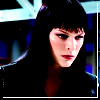
CADENCE JAMES OC
After a turbulent childhood involving a neglectful father, an absentee mother, and a terminally ill older brother, telepathic-telekinetic mutant Cadence was taken in from New York’s streets by Jean Grey, who brought her to live at the Xavier Institute. Various escapades have afforded her few relationships: best friend Kurt Wagner, acquaintance Ororo Munroe, and a snakelike mutant child named Akira who refers to her as “oba-chan”. Cadence’s demeanor has always been pessimistic and violent; the death of Jean and the Professor, who were her mentors and first friends, caused her to withdraw. A budding romance with Warren Worthington III may be helping her tendencies, but her trust remains an elusive gift.
0 notes
Link
Blue Origin’s New Shepard rocket successfully launched and landed today at the company’s Launch Site One in West Texas, with an uncrewed science and goodwill payload onboard. This was the 24th New Shepard flight and 13th payload mission today from Launch Site One in West Texas. This marked the first flight since September of 2022 when the uncrewed NS-23’s booster suffered an in-flight anomaly; however, the escape system jettisoned the capsule, which was able to land safely. With the success of NS-24, Blue Origin hopes to soon restart its commercial passenger flights. “We look forward to flying our next crewed flight soon,” said Erika Wagner, senior director of emerging market development for Blue Origin, at the end of the launch broadcast. Watch the liftoff and landing below. Liftoff occurred at 10:43 Central Time, with the capsule reaching about 106 km (66 miles) at its highest point. The 33 science experiments on board experienced about three minutes of microgravity before the capsule safely touched down under three parachutes — with a retrorocket to cushion the landing — approximately 10 minutes after launch. Returning to ?. #NS24 pic.twitter.com/kebApFAl8K— Blue Origin (@blueorigin) December 19, 2023 The rocket booster touched down vertically about seven minutes after launch, on a landing pad 3.2km north of the launch pad. The first launch attempt for the mission was scrubbed on Monday due to a ground system issue. But today’s countdown and launch went smoothly. Booster touchdown. #NS24 pic.twitter.com/Z4keYXzlby— Blue Origin (@blueorigin) December 19, 2023 The payloads on board included research from NASA, academia, research institutions, and commercial companies, as well as student experiments from classrooms in Maine, New Mexico, and Kansas. New Origin said New Shepard has now flown more than 150 payloads to space. Also on board were about 38,000 postcards as part the company’s Postcards to Space program. Each postcard will be returned to its creator stamped “Flown to Space.” To send a postcard on future mission, see the company’s Club for the Future website. “A special thank you to all of our customers who flew important science today and the students who contributed postcards to advance our future of living and working in space for the benefit of Earth,” said Phil Joyce, Senior Vice President, New Shepard, in a press release. “Demand for New Shepard flights continues to grow and we’re looking forward to increasing our flight cadence in 2024.” When will New Glenn fly? Meanwhile, Blue Origin is hoping to finally deliver on their next big project, the massive New Glenn rocket which will be capable of bringing satellites and other large payloads to orbit and beyond. But the rocket is years behind schedule. Initially, Jeff Bezos said that New Glenn would be ready to launch by 2020, but the latest estimate is that the first launch is expected to take place no earlier than August 2024. NASA and Blue Origin announced in February 2023 that the first launch of New Glenn will carry NASA’s EscaPADE spacecraft to Mars. The Escape and Plasma Acceleration and Dynamics Explorers mission is a small planetary science mission that will use two spacecraft to measure plasma and magnetic fields around the Mars. With simultaneous observations from two locations from orbit, scientists hope to learn more about the processes that strip away atoms from the magnetosphere and upper atmosphere on the Red Planet. In rocketry, size definitely matters. Image: Blue Origin New Glenn will reach a towering height of 95 meters (313 ft) which will dwarf any other commercially available vehicle. And it will be capable of delivering 45 metric tons, almost 100,000 pounds, into Low-Earth Orbit (LEO). But if New Glenn can’t get off the ground by late 2024, it will miss the launch Mars launch window, and have to be delayed until 2026. Mars launch windows typically come every 26 months. ESCAPADE was originally scheduled to launch as a secondary payload NASA’s Psyche mission which blasted off on a Falcon Heavy rocket in October, but NASA removed ESCAPADE from the launch because it would not provide the mission with the proper trajectory. The post Blue Origin’s New Shepard Completes 24th Flight; New Glenn Hopefully on the Horizon appeared first on Universe Today.
0 notes
Text


Colin and I encourage our girls to journal at every turn! It's such a valuable way for them to connect with God, think through decisions, and manage all the emotional ups and downs of adolescence. Charlotte in particular has been a busy bee. She's such a great role model for her sisters!
#gosh they just look so happy don't they#charlotte wagner#cadence wagner#sophia wagner#wagners#wagner family#gen1#**#fundie sims#quiverfull sims#homeschool sims#ts4#sims 4#ts4 legacy#sims 4 screenshots
9 notes
·
View notes
Text
danny wagner says “bitches” with a cadence and frequency that makes me believe it is maybe the only swear word he has and will ever say
#B I T C H E S#hes clearly excited to say it#also im in love with him#gvf#greta van fleet#danny wagner
26 notes
·
View notes
Note
Slightly off the usual topic, but how realistic is the idea of an army going into battle with someone playing some sort of music on whatever very loud instrument the technology allows? This is partly prompted by the battle scene in the new Dune movie, where I'm pretty sure the bagpipe music over the big battle is meant to be something the characters can hear, as it's the same music the piper is shown playing in an earlier scene, but as a folk music nerd I was already intrigued by the idea
There's a lot of history there, and it's an area that I'm not an expert on. The very short version would be that: Yes, music has had a very important role on the battlefield.
It gets a little more complicated when you move beyond that, because music did a lot of things in various contexts. Instruments were used to help maintain cadence, help maintain morale, and to quickly communicate orders. This included the bagpipes, which were famously used to boost troop morale in battle, as recently as the first World War. (Various) drums and horns are the other examples frequently given, and I'm not sure how many other instruments saw battlefield use like this.
Playing recorded music into battle has some history as well, though the major example is fictional. In Apocalypses Now, Lt Colonel Killgore's Air Cavalry blasts Ride of the Valkyries while leading an assault on a fishing village. While the example is fictional, there's actual history with using music recordings to demoralize enemies. There were unconfirmed reports of American tank crews emulating Apocalypses Now's use of Wagner in Iraq. (I'm slightly hesitant to include this, because I can't confirm it, but it's also entirely plausible.) There are dozens of instances where loud music has been used to harass or distract hostile combatants. This tends to be more about use outside of combat. The Korean DMZ has been the site of multiple musical assaults like this (granted, with K-pop as the preferred vector.) Also, this seems to be an extremely recent development, (at a guess, within the last 30 years) which shouldn't be much of a surprise, given how, until recently, sound equipment that would be loud enough to be heard over combat would have required dedicated vehicles. I'm not aware of any non-fictional examples of those, outside of, maybe, some propaganda trucks.
There's adjacent issue you may want to research a bit further on your own time, and it might dovetail into this. There's a lot of scholarly lit on the use of music as propaganda during the world wars. The use of music as a wartime propaganda vector was not new, but it might be a good jumping off point into the further use of music as a morale booster.
-Starke
This blog is supported through Patreon. If you enjoy our content, please consider becoming a Patron. Every contribution helps keep us online, and writing. If you already are a Patron, thank you, and come join us on Discord.
166 notes
·
View notes
Text
I adore this. Loved the original comic, love that Logan always has his back.

Kurt.
#nightwolves#logurt#tom fowler#your private dancer#nightcrawler#inking#commissions#cadence comic art#kurt wagner#wolverine
161 notes
·
View notes
Text
Tristan und Isolde in The Good Fight 6x04
i was not always an opera fan but i am always a fan of art referencing art. so when Tristan und Isolde popped up in season 6 of The Good Fight, you can imagine i was intrigued.
again, i wrote two threads on twitter, and i'm reposting here in lieu of there never being another thursday ep of TGF ever again (crying hours).

by Spanish artist Rogelio de Egusquiza's Tristan and Isolde (Death). 1910, oil on canvas, Bilbao Fine Arts Museum
anyways, T&I is an opera in 3 acts by Richard Wagner with a German libretto, based on a 12C romance Tristan and Iseult by Gottfried von Strassburg. known for tonal ambiguity, orchestral colour, harmonic suspension & chromaticism (very basically, using tones outside major/minor scales).
i will say from the outset i am not a Wagner fan (google it, but also it's rather ironic given what happens in this ep), but i have been to the villa where he lived in Lucerne (great views). (Walter Benjamin called Wagner an example of "bourgeois false consciousness" lolol)
anyway back to T&I… he wrote it while having an apparent affair with Mathilde Wesendonck 👀🍵 but it was also written after his discovery of Schopenhauer, a German philosopher who also influenced Tolstoy.
his point was to write tragedy, not romance, and his work marks the departure from tonal harmony in 20C EU classical music. the opening is called the Tristan chord—listen to the dissonance, nothing being resolved.
T&I uses harmonic suspension—creating musical tension and expectation in the listener through prolonged unfinished cadences. but he does so throughout the whole work, like introducing a cadence in the prelude and not resolving until Act 3 Finale.
and um, this deferred resolution is frequently interpreted as symbolising both physical sexual release and spiritual release (aka death ahah). there is also a day/night, life/death theme going on—opposites attract.
to return to Schopenhauer and the general storyline of T&I, it's really premised on the idea of unfulfilled longing and unachievable desires. make of that what you will.
[pre-finale addendum] i never really thought T&I was a direct metaphor, but more about how love doesn't always triumph. tragedy.
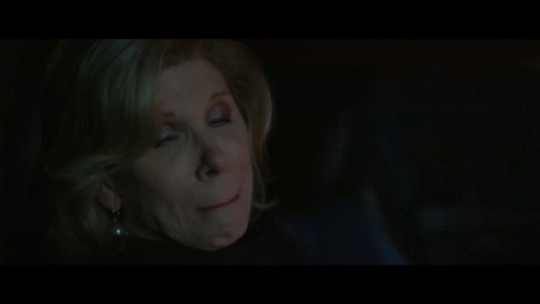
the important thing about the T&I plot is that it's a chivalric romance with certain elements, based on ancient Celtic myth, though the opera itself is based on a Medieval German retelling:
the brave hero (you're my hero)
the forbidden/doomed lovers (can your love survive outside the bubble)
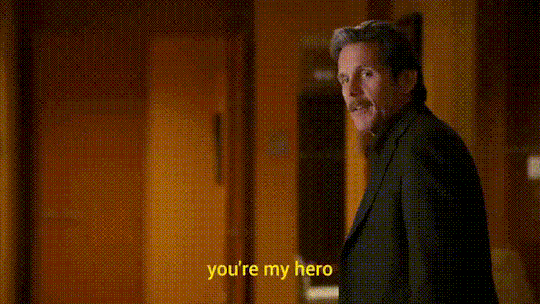
and of course, the love potion, which makes Isolde fall in love with Tristan whom she had previously sworn hatred for after he killed her uncle. it SHOULDN'T make sense, and yet Diane and Kurt fall in love anyway.

the love potion is magic, but it is also poison (this is where it could become a metaphor* for PT108). and it doesn't just slowly poison them, eventually in the opera it poisons everything and leads to the lovers' downfall.

****(ftr, i do not think PT108 itself is poison & certainly not in reference to a depression treatment)
there are interesting doubles in T&I, mostly that Tristan's first wound is healed magically by Isolde, but later he's mortally wounded when Isolde doesn't reach him in time.

(Rogelio de Egusquiza, Tristan and Isolde (Life). 1910, oil on canvas, Bilbao Fine Arts Museum)
i think we see this flipped in TGF. in s1-2, Di has been wounded emotionally by Kurt and eventually they reconcile. but in s6, Di has been depressed and had multiple near death experiences, and yet Kurt doesn't seem to be able to reach her.

hence the quote: 'Here he lies, the great man, in thrall to the world’s most wonderful delusion—love.' and like the opera, the harmonies won't resolve until the very end.
[post-finale note] i did realise that when the Liebestod is playing while Diane and Kurt are talking on the sofa after the gala dinner that it does resolve. the answer was always there, that they would resolve together.
youtube
#tristan und isolde#richard wagner#the good fight#the good wife#diane lockhart#christine baranski#robert and michelle king#nat's tangents#the good universe#nat's art history threads#the art of referencing art in art
12 notes
·
View notes